James E. Storrar and the "defector" Yak-9M
by Erik Pilawskii
For years and years, through such sources as Air International or Pilot Press, one could have seen a photograph of a Yak wearing RAF roundels. Invariably, this machine was referred to as a "Yak-9D" or even a "-9T", and when attempted the various profiles provided were completed in the usual RAF-style "green/brown" camouflage (strangely apropos, that). As was also usual, nothing more really about this aircraft was presented in the captions.
Such was the state of affairs with regards to this specific Yak when I happened across Santiago Hrubisko, son of master RAF-theme modeler Raúl José Hrubisko, who together have produced some startling and quite huge collections of models in British service during WW2. Some of these may be seen in the following links:
1)
Family Resemblance, Hawker Tornado-Typhoon-Tempest-Sea Fury Line
http://www.ipmsstockholm.org/magazine/2005/05/stuff_eng_hrubisko_typhoon.htm
2)
Modelling for a Lifetime, A Story About the Ultimate Spitfire Collection
http://www.ipmsstockholm.org/magazine/2003/11/stuff_eng_hrubisko_spitfire.htm
3)
Passion for Mosquitoes
http://www.ipmsstockholm.org/magazine/2006/01/stuff_hrubisko_mosquito.htm
4)
Tailless and Canard Experimental Aircraft of the RAF
http://ipmsstockholm.org/magazine/2006/06/stuff_eng_hrubisko_tailless.htm
5)
47 Miles of Scratchbuilding
Part
1: Modelling the History of the Miles Aircraft Company
http://ipmsstockholm.org/magazine/2007/01/stuff_eng_hrubisko_miles_01.htm
Part
2: From Miles Magister to Supersonic M52 http://ipmsstockholm.org/magazine/2007/01/stuff_eng_hrubisko_miles_02.htm
6)
Lend-Lease Aircraft in the Fleet Air Arm
Part
1: http://www.ipmsstockholm.org/magazine/2007/09/fleet-air-arm-models-01.htm
Part
2: http://www.ipmsstockholm.org/magazine/2007/10/fleet-air-arm-models-02.htm
Part
3: http://www.ipmsstockholm.org/magazine/2007/11/fleet-air-arm-models-03.htm
7)
Early British Jets
Part
1: Gloster's Contribution: http://www.ipmsstockholm.org/magazine/2008/06/early-british-jets-01.htm
More than impressive, indeed. But, germane to the point, we came to discuss this Yak-9, or more accurately to say what we thought must be several Yak-9s. Why more than one, and why the confusion?
The course of these e-mail discussions followed the examination of the evidence surrounding this matter. This exchange of ideas was quite enjoyable, and, as it exposed so many contradictions, lead somewhat tortuously to an understanding of the correct picture surrounding this Yak. It is the story of the unfolding of these discoveries which I wish to relate here.
Anecdotal Testimony
The confusion really started in 1993. During that year I attended Duxford for the usual seasonal flying exhibition in the summer (I don't recall if it was known then as "Flying Legends"). Whilst at Duxford I was introduced to several ex-RAF pilots. Amongst these was a bloke by the name of James E. Storrar. Storrar was not then in the best of health (I believe he died in 1995, actually), but after being told that I was an "expert on Russian aircraft" he was keen to tell me about his Yak-9. Needless to say, I was quite intrigued.
Over the course of lunch Storrar related what he knew about this aircraft. In the simplest terms, Storrar did not recall what version Yak-9 he had in Italy. He had recalled that he was posted there in 1945, and told me somewhat wistfully that he got the Yak from "a visiting Russian pilot." He then went on to describe in absolutely correct detail the operation and technical details of the fuel system of the Yak-9D fighter. I was quite stunned to hear such detail, one can imagine. More than that, he spoke in glowing terms of the handling of his Yak-9, his admiration for the aircraft, and his various mock dog-fights against the other members of his squadron, who, piloting their heavy P-51D fighters, were left "red-faced with frustration" following these contests.
With regards to the appearance of this Yak, Storrar stated that he took no photographs of this aircraft, nor did he know of any surviving images. He recalled that this machine had a personal code on the side of "J-ES" (he wrote it down exactly as shown) which I took to be equal to his initials, and thereby similar to other personal codes such as Johnny Johnson's. Further, he was sure that the Yak received RAF roundels.
It was from this conversation that I had always come to understand that Storrar must have piloted a Yak-9D model. How else on earth could the man have come to understand the fuel system of this machine? This version also agreed with the inventory of the VVS Yak-9 units operating in the area adjacent to northern Italy in the immediate post-War period (summer 1945). "Case closed", I thought.
The Treviso Yak
During the summer of 1946 a Bulgarian pilot landed his Yak-9M fighter on the aerodrome at Treviso, northern Italy. The episode was invariably decsribed in Western literature as a political "defection", but whatever the truth (or not) of this claim the aircraft was indeed impounded by British authorities and distributed to the local RAF unit at the field. Many images-- most of them desperately poor in quality-- were published over the years of this aircraft in RAF markings. The various captions were invariably in error, describing the machine as virtually any Yak-9 version (from -D to -U), and demonstrating the customary lack of understanding of VVS subject matter.
It was often the case, as well, that some publications printed images of this very Yak-9M with the caption that the aircraft was the same which belonged to J.E. Storrar. Moreover, some of these captions also claimed that his personal code was applied to the machine, this being "JAS".
Multiple Yaks in Italy
Looking to these various images it was clear to me that the aircraft in view was a Yak-9M, and indeed in each case the same -9M. Confident that Storrar's 1945 Yak-9 was a -D model, I dismissed any possibility that these photos demonstrated his aircraft. This idea agreed with his comment that no photographs of his Yak existed, and also with his recollection of the code "JES", which appeared in no published image. In fact, no code was visible in any such published image which I recall from the time. The time-frame seemed to be one year later than Storrar's Yak, also, which explained the different versions very well.
On this basis I decided that it was most likely that there was more than one Yak-9 in northern Italy during this period. Indeed, this picture was clouded all the more by yet another episode involving the Soviet VVS. In March of 1946 a "Russian fighter" aircraft landed "in northern Italy" by error. This was certainly no case of "defection", as the pilot explained his mistake and demanded to return to his unit. Indeed, an official complaint was sent by the Red Army command in Yugoslavia to the Allied Control Committee in Italy about this matter. However, the aircraft and pilot were kept in Italy for some three weeks before he and his machine were allowed to return. So, what befell this aircraft in that time?
The most likely aircraft to have been involved in this incident was again a Yak-9. There was, of course, no evidence available on what sort of machine was actually involved, but could it have been so that during 1945-46 that three Yak-9s were in RAF hands? It seemed to be a distinct possibility.
New Investigations by Santiago
When I came into contact with Santiago, at last, the conversation about Storrar's Yak-9 began with my rendition of his testimony, and my interpretation of the meaning of the same. However, quite correctly Santiago began to cast about for more information, posting questions on a few aviation history type forums. What began to emerge from the various postings was in direct contradiction to the story as I understood it.
Firstly, the factual whereabouts of James Storrar were determined. His posting to Italy as Wing Commander of 239 Wing was actually completed in 1946, not in 1945 as recalled. His basing was indeed at Treviso where the Bulgarian Yak-9M was known to have been. Whilst at Treviso, Storrar was equipped with a Mustang IV bearing the personal code "JAS" (Jas is an old-fashioned nick-name for James, now rarely used), and not "JES" [n.b. I have seen a personally held photograph of this Mustang with its code, but I have no permission to reproducce it here]. In fact, we discovered that 'Jas' was rather Storrar's "official" (as such) nick-name, and was used often when referring to this chap.
Anyone who interviews old pilots from WW2 will know that memories of many details fade over the years. This is normal and natural, and no one should be confused or alarmed by such things. As details of Storrar's service began to emerge, we began to question his recollection of events considerably.
At the same time, Santiago's inquiries were bearing fruit. Several new images of these aircraft began to appear, in particular photographs of the Treviso Yak-9M still in its Bulgarian markings. These were of better quality than any images seen before. In fact, working on the suspicion that these photos showed the same Yak-9M as in the other various "Treviso" or "Storrar" Yaks, I decided to revisit the older images and see if anything could be teased out of these poor views.
JAS?... Shocking
The first such image threw up rather a shock. The original image, as widely published, is shown below, left. The modified image, based on manipulations to the image using the 'new' Bulgarian pictures as a guide, is found right.
Not only were many more details of the camouflage and markings of the aircraft revealed, but there came clearly into view a code on the fuselage. "JAS", indeed!
At first I regarded this code with the greatest scepticism. It is very poorly applied and rather sloppy, and the black colour seemed questionable to me. This kind of code would have been quite easy to apply to the image after-the-fact, even before digital imaging tools were available. How convenient, I thought, that an image of Storrar's aircraft would be "found" if he said there was none? Furthermore, should not his Yak-9 be a -D model, not an -M?
However, the enhanced image did indeed confirm one important point-- namely, that all of the images of Yaks in Italy showed exactly the same aircraft. There was this ex-Bulgarian example, and no other.
The Mystery Revealed
It was when Santiago and I combined this observation with the actual timing of Storrar's service in Italy that the puzzle began to be solved. Since there was evidence only of one Yak-9 in RAF markings, and since this same example appeared just after Storrar arrived on the base, and since the same aircraft looks to have had the code "JAS" on it, and since the story of the aircraft's ultimate demise was identical in both cases (ceremonially burned after it was no longer airworthy), we concluded that the Treviso ex-Bulgarian Yak was in fact Storrar's Yak.
It has to be. The evidence agrees only with this interpretation. That is our conclusion.
However, it is also important to point out that some small mysterious details remain. The most pressing of these, actually, is Storrar's knowledge of the Yak-9D fuel system. The -D had four wing cells plus an auxiliary oil tank the fuselage. There was a special fuel selector control for the system which was not seen in any other Yak-9 model. Storrar recalled all of these items in perfect detail. How on earth is this explained if his Yak was a -9M?
I can think of two possibilities, but perhaps there are more. In the first case, it is possible that the aircraft in the 'March 1946 incident' was indeed a Yak-9D. In this way Storrar might have seen this example, or any technical documentation written about it. Similarly, there might have been RAF pilots at his airfield (or nearby) who were stationed at Bari, Italy, during 1944 when Yak-9Ds and -DDs operated from this base. Such pilots would likely have knowledge of this system. As pilots with 'Yak' interests, they could easily have come into contact with each other and shared information. Whatever the truth, we simply do not know the correct answer.
The small "JAS" code is just not entirely convincing. Storrar's Mustang has a very nicely applied and attractive JAS code on on the fuselage, complete with coloured trim and outlining. Why would his favourite Yak aircraft have a crude, hand-scrawled code on it, especially noting that very nicely proportioned RAF roundels and other careful re-finishing had been applied to the same machine? This makes no sense to me at all. It is still possible that indeed the small codes seen in the image are not authentic, and were added after-the-fact (presumably by someone who reckoned they should be present). It is possible that the aircraft had another appearance featuring 'proper' JAS coding as seen on the Mustang. Alas, until such an image is found, we will never know.
The Evolution of "White 39"
"White 39" fell into RAF hands during August 1946. We can speculate about some things of its life prior to that time, but certainties are not available at the time of writing.
In Bulgarian service, "39" appeared much as it did when it was likely in VVS service hitherto. The re-finishing seen on the aircraft, along with some curious details, certainly point to a machine with an operational history, and not one coming straight from the factory. This Yak-9M featured a spinner of an earlier pattern, one seen on the original Yak-9 with an extended Hucks collar. This unit was not common on the -M model, which usually demonstrated the rounded 'Yak-3' type spinner. As well, "White 39" has a blast tube extending out of the UBS opening in the cowling, this again a feature more usual on the Yak-9. Such things might easily be repair or replacement items; it is impossible of course to know.
Upon receipt from the VVS, "39" was refinished for Bulgarian use. The original NKAP Template AMT-11/-12/-7 camouflage application is manifestly evident. The Soviet star markings were over-painted with what certainly looks to have been AMT-12 lacquer; one presumes that quantities of such were supplied with the aircraft. In fact, a fair portion of the fuselage seems to have been so painted. This causes one to wonder if the tactical numbers, themselves, were original or applied in Bulgaria? Without doubt, the 'stencil style' of these numbers is similar to others seen on Bulgarian aircraft. However, they also demonstrate the same tonal properties of worn or opaque white colour as does the spinner, and in contrast to fresh white colour appearance of the Bulgarian insignia. Could these numbers be the original VVS applied items, suitably modified via over-painting to have a more 'Bulgarian' appearance? Was the spinner painted white previously in VVS service (such colouration was certainly common enough)?


The small white triangle marking on the rear fuselage is of interest. This item was applied to military equipment in Bulgarian Army service. Essentially, the stencil gave a code referring to the aircraft type and to the unit's sequential order of receipt. A very fine page can be found here describing this system.
After "39" was 'adopted' by the RAF it was again re-finished suitably for such service. RAF style roundels were applied to the fuselage and wing undersurfaces, and likely to the uppers as well (alas, there is no useful photographic evidence on this point, although one would expect an RAF machine to have them). Parts of the fuselage sides and fin/rudder were painted over with what is likely to have been RAF Ocean Grey (as shown), although perhaps a similar finished was employed. The spinner looks to have been painted with red colour. An RAF fin flash was added to the vertical stabiliser.


At some point after the aircraft received its RAF markings, it may be so that Storrar's personal code 'JAS' was applied. The suggested appearance on the available image is for black letters, these having been applied by hand rather casually if the appearance shown in the photograph is authentic. There is no available view of the port side showing such codes.

We can hope that additional images of this fascinating Yak-9 appear in future, adding to our understanding of its complex and evolving appearance.
Photo Gallery
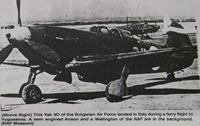 |
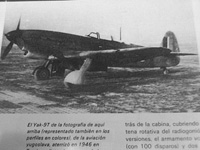 |
 |
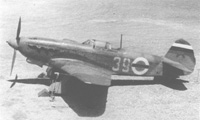 |
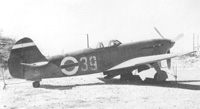 |
 |
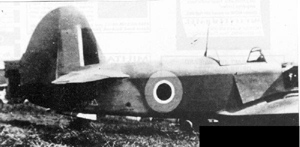 |
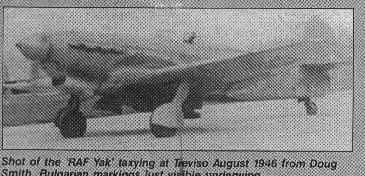 |

